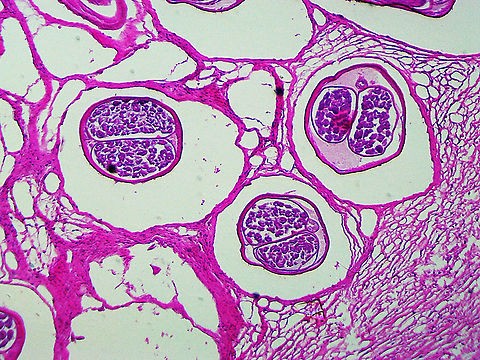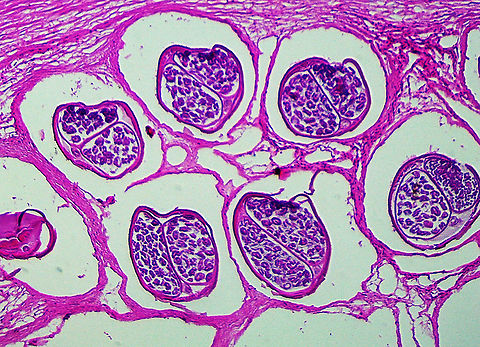
Appearance
''O. volvulus'' parasites obtain nutrients from the human host by ingesting blood or by diffusion through their cuticle. They may be able to trigger blood-vessel formation because dense vascular networks are often found surrounding the worms. They are distinguished from other human-infecting filarial nematodes by the presence of deep transverse striations.It is a dioecious species, containing distinct males and females, which form nodules under the skin in humans. Mature female worms permanently reside in these fibrous nodules, while male worms are free to move around the subcutaneous tissue. The males are smaller than females, with male worms measuring 23 mm in length compared to 230–700 mm in females.
The release of oocytes in female worms does not depend upon the presence of a male worm, although they may attract male worms using unidentified pheromones. The first larval stage, microfilariae, are 300 μm in length and unsheathed, meaning when they mature into microfilariae, they exit from the envelope of the egg.

Naming
John O’Neill, an Irish surgeon, first described ''Onchocerca volvulus'' in 1874, when he found it to be the causative agent of ‘craw-craw’, a skin disease found in West Africa. A Guatemalan doctor, Rodolfo Robles, first linked it to visual impairment in 1917.''O. volvulus'' is primarily found in sub-Saharan Africa, and humans are the only known definitive host. It is spread from person to person via female biting blackflies of the genus ''Simulium''.
Evolution
''O. volvulus'' has low genetic variation between individuals. This suggests a population bottleneck occurred in the past that caused a rapid decrease in the population size. It also shows high haplotype diversity, which is a measure of how unique a group of linked genes is. This pattern of low genetic variation and high haplotype diversity suggests fast population expansion after a bottleneck and has led to the theory that a host shift event from cattle allowed ''O. volvulus'' to infect humans. This is also supported by genetic data that place ''O. ochengi'' as the sister group to ''O. volvulus''.References:
Some text fragments are auto parsed from Wikipedia.